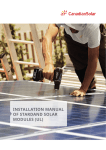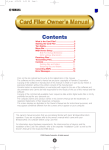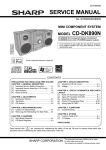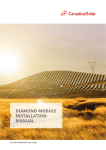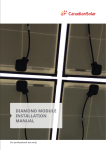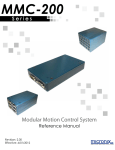Download INSTALLATION MANUAL ANNEX OF STANDARD
Transcript
INSTALLATION MANUAL ANNEX OF STANDARD SOLAR MODULE ANNEX A: ALTERNATIVE MOUNTING METHODS |3 ANNEX B: ALTERNATIVE GROUNDING METHODS |10 ANNEX C: MODULE SPECIFICATION |15 ANNEX D: MODULE CLEANING GUIDELINE |18 AMENDED EDITIONS AND DATES |19 EN-Rev IM/GN-AM-EN/A2 Copyright © Dec. 2014. Canadian Solar Inc. ANNEX A: ALTERNATIVE MOUNTING METHODS All the basic requirements of the main installation · Canadian Solar Inc. warranty may be void in cases manual should apply to the alternative mounting where improper clamps or unsuitable installation methods, unless otherwise specified. methods are found. When installing inter-modules or end type clamps, take measures so as: MOUNTING METHOD A CLAMPING Not to bend the module frame Not to touch or cast shadow on the front glass Not to damage the surface of the frame To ensure the clamps overlap the module frame · The mounting method has been qualified by by at least 0.2 in (5 mm). Canadian Solar Inc. and certified by VDE and CSA. · Top or bottom clamping methods can vary and To ensure the clamps overlap length is at least 1.57 in (40 mm). are dependent on the mounting structures. The installer shall follow the mounting guidelines, Min. 3 mm thickness recommended by the mounting system supplier. · Each module must be securely fastened at a minimum of 4 points on two opposite sides. The clamps should be positioned according to the authorized position ranges defined in table A-1. Install and tighten the module clamps to the mounting rails using the torque stated by the mounting hardware manufacturer. M8 size bolt and nut are used for clamping method. Tightening torques should be within 10~17 Nm (7.4~12.5 ftlbs) for M8 x 1.5 coarse thread bolts, depending on Min. overlap length bolt class. Min. 5 mm overlap 40 mm · Different recommendations from specific clamping hardware suppliers should prevail. System designer · Clamp material should be anodized and installer are responsible for load calculations aluminum alloy. and for proper design of support structure. · Floating type clamps are not authorized. · Clamp positions are of crucial importance for the reliability of the installation, the clamp centerlines must only be positioned within the ranges indicated in table A-1, depending on the configuration and load. · For configurations where the mounting rails run parallel to the clamps installation side, precautions should be taken to ensure the module frame (C-shape) overlap the rail by 0.59 in (15 mm) or more. www.canadiansolar.com 4 | Table A-1: Authorized attachments for clamping method Uplift load ≤ 2400 Pa Uplift load ≤ 2400 Pa Downforce load ≤ 2400 Pa 2400 Pa ≤ Downforce load ≤ 5400 Pa Use 4 clamps on the long side, the allowed range depends on the module type. Use 4 clamps on the long side, the allowed range depends on the module type. A1 A1 B1 B1 A1 A1 B1 B1 Clamping on long side frame Mounting rails shall run perpendicularly or parallel to the long side frame . Mounting rails shall run perpendicularly or parallel to the long side frame . Use 4 clamps on the short side, the allowed range depends on the module type. Mounting rails shall run parallel or perpendicularly to the short frame side. Use 4 clamps on the short side, the allowed range depends on the module type. An additional support bar should be placed below the module. A2 A2 A2 A2 A2 A2 A2 A2 Support bar Clamping on short side frame For CS5P and CS6P series, an additional support bar should be placed below the module where download force above 1600Pa is expected. Mounting rails should run parallel to the short side frame . A2 A2 A2 A2 Support bar EN-Rev IM/GN-AM-EN/A2 Copyright © Dec. 2014. Canadian Solar Inc. Mounting rails should run parallel to the short side frame . | 5 Authorized range for clamping as a function of model type: Model type A1 range (mm) B1 range (mm) A2 range (mm) CS5A 220 – 380 330 – 400 170 – 200 CS5AH 120 – 170 120 – 170 170 – 200 CS5P 220 – 390 330 – 400 220 – 270 CS6A 220 – 340 270 – 330 200 – 250 CS6P, CS5T 240 – 410 340 – 410 200 – 250 CS6X 340 – 550 410 – 490 200 – 250 CS6V 240 – 410 340 – 410 170 – 210 CS6VH 130 – 210 160 – 210 170 – 210 CS6K 247.5– 410 247.5– 330 200– 250 MOUNTING METHOD B INSERTION SYSTEMS · The mounting method has been qualified by Canadian Solar Inc. and certified by VDE and CSA. To ensure insertion profile thickness and tolerance suits module thickness 1.57 in (40 mm) for most of Canadian Solar inc · Insertion methods can vary and are dependent modules). on the mounting structures. The installer shall follow the mounting guidelines, recommended by the mounting system supplier. · Each module must be securely fixed through all its length on two opposite sides. Install and tighten the insertion profiles to the support structure using the hardware and instructions provided by the mounting system manufacturer. System designer and installer are responsible for load calculations and for proper design of support structure. · Canadian Solar Inc. warranty shall be void in cases where improper insertion systems or unsuitable installation methods are found. When installing insertion profiles, take measures so as: Not to bend the module frame Not to touch or cast shadow on the front glass Not to damage the surface of the frame To ensure the insertion profiles overlap the module frame by at least 0.39 in (10 mm). To ensure the module frame (C-shape) overlap the insertion profiles by at least 0.59 in (15 mm). www.canadiansolar.com 6 | Table A-2: Authorized attachments for insertion method Uplift load ≤ 2400 Pa Uplift load ≤ 2400 Pa Downforce load ≤ 2400 Pa 2400 Pa ≤ Downforce load ≤ 5400 Pa Insertion profile on long side Use 2 insertion profiles running parallel to the long side frame. For CS6X series, installations where the downforce load can reach up to a 5400 Pa are authorized. frame Insertion profile on short side frame Use 2 insertion profiles running parallel to the short side frame. For CS5P and CS6P series, an additional support bar should be placed below the module where download force above 1600 Pa is expected. Use 2 insertion profiles running parallel to the short side frame. An additional support bar should be placed below the module. For CS6X series, installations where the downforce load can reach up to a 5400 Pa are authorized. MOUNTING METHOD C Grizzly Bear® FR Gen II SYSTEM · Grizzly Bear® FR Gen II System has been qualified Components by Intertek (ETL) to UL2703 for use with Canadian Solar Inc. modules. EN-Rev IM/GN-AM-EN/A2 Copyright © Dec. 2014. Canadian Solar Inc. Support Claw I Long Claw Wind Deflector Wind Deflector End Plate Fastener Kit | 7 Table A-3: Authorized attachments for Grizzly Bear® FR Gen II SYSTEM Claw Compatible Modules Installation Methods Claw I Place a PV module face down on protected CS5A series, , CS5T-M, work surface and place a Claw over the CS6P series, CS6A series, module frame flange on the short side of CS6X series the module; slide to the corner and tighten the 3/8-16 x 1.25” 18-8 hex head cap screw Only 1600Pa is autho- between 24.4 and 27.1 Nm (18-20 ft-lb). En- rized for CS6P/CS6X sure that the Claw is seated up against the without support bar. flanges of both the long and short sides of the module. Each module must be fitted with four (4) Claws. Long Claw This Claw is used for PV modules that are not compatible with flange clamp style Claws. The Long Claw attaches at the CS6X-M, CS6X-P module mounting holes using standard bolting method. Refer to paragraph 6.1 for suitable torque and fastening requirements. · Refer to Grizzly Bear® FR Gen II Installation Manual (9910010 Rev A) from PanelClaw Inc. for more information and always follow latest safety procedures when installing. Failure to follow corresponding regulatory instructions will void Canadian Solar Inc. module warranty. www.canadiansolar.com 8 | MOUNTING METHOD D ATI CLAMPING module) to maintain a balanced force with the end module. · The mounting method has been qualified by · The top module edge must engage the clamp a Canadian Solar Inc. and certified by CSA. minimum of 0.375 in (9.5 mm) on the top clamp edge and the bottom module edge must engage a · Array Technology Inc. (ATI) uses a clamp mounting minimum of 0.69 in (17.5 mm) on the bottom method for attaching modules to the tracker clamp edge. If these distances cannot be assembly. The clamp mounting method involves measured, a total of 0.062 in (1.57 mm) of gap is installing a module mounting clamp assembly allowed between the module and both clamps. on the torque tube, attaching a module, and then This gap can be offset to one side or split between another clamp assembly until the row of modules the clamps. is installed. Clamps may also be installed earlier, when bearing housings are installed on torque tubes. · All the clamp assemblies, spacer plate, and hard ware should be tightened to the torque tube with a torque setting of 18 ± 3 Nm (13 ± 2 ft-lbs), using · Canadian Solar Inc. qualified 2 kinds of ATI clamps, the long bolts provided (bolt length is dependent 12 in (304.8mm) length standard clamp and 12 on model used). in (304.8mm) length high-clearance clamp. Both Top Channel clamps are mounted on long side frame, in the middle position (with Universal Clamp Module Jig), so that the module is evenly divided in half by the torque tube. · End clamps are attached to the module at the end of each array and in the middle next to the gear drive. Four end clamps are used for each row of modules. End clamps are at least 22 in (558.8mm) long and have four attachment holes. End clamps also include a spacer plate (fabricated for each specific module) that must be inserted in the clamp Bottom Lip on the outside of the clamp (opposite the end (Wider Flange) Module Mounting Strap Table A-4: Authorized attachments for ATI clamping CS6P Series CS6X Series 12-inch length Uplift load ≤ 1200 Pa Uplift load ≤ 2400 Pa standard clamp Downforce load ≤ 1200 Pa Downforce load ≤ 5400 Pa 12-inch length Uplift load ≤ 1200 Pa Uplift load ≤ 2400 Pa high-clearance clamp Downforce load ≤ 3600 Pa Downforce load ≤ 5400 Pa · Refer to DuraTrack™HZ Solar Tracker Installation Guide (November 2012, Rev. B-01) from Array Technologies Inc. for more information and always Intermediate follow latest safety procedures when installing. Clamp End Clamp Failure to follow corresponding regulatory instructions will void Canadian Solar Inc. module warranty. Torque Tube EN-Rev IM/GN-AM-EN/A2 Copyright © Dec. 2014. Canadian Solar Inc. UCM Jig | 9 MOUNTING METHOD E FOR SPECIFIC MODULE RANGES 1. Not to bend the laminate excessively 2. Not to cast shadow on the cells FLOATING CLAMPED CONFIGURATION 3. Not to damage or scratch the surface of the (ONLY FOR CS5A-M-L LAMINATE MODEL) glass and backsheet 4. To ensure the clamps overlap the module glass · The mounting method has been certified by CSA. · Clamping methods can vary and are dependent 5. To ensure the clamps overlap length is at least by at least 0.47 in (12 mm). on the mounting structures. The installer shall follow the mounting guidelines, recommended by 6. To ensure a minimum contact area of 1.57 in x the mounting system supplier. 3.0 in (76 mm). 1.18 in (40 mm x 30 mm) between the clamp and the mounting rails (rail thickness should be · Each laminate must be securely fastened at a at leat 1.57 in (40 mm)). minimum of 8 points on the two opposite long sides. Clamp positions are of crucial importance 7. To use clamps of appropriate thickness, for the reliability of the installation, the clamp allowing the CS5A-M-L 0.157 in (4 mm) glass laminate to be fixed floatingly. centerlines must only be positioned within the ranges indicated in table A-5. Install and tighten the module clamps to the mounting rails using Min. overlap length the torque stated by the mounting hardware 76 mm manufacturer (in the absence of instructions, Canadian Solar Inc. recommends a torque about 15 Nm to 20 Nm (11.1 to 14.7 ft-lbs)). System designer and installer are responsible for load calculations and for proper design of support Min. 12 mm structure. overlap · Clamp material should be aluminum. EPDM type rubber or similar material should be used between Min. overlap length 30 mm the laminate/clamp and laminate/mounting rail interfaces in order to prevent any damages to the laminate. · Canadian Solar Inc. warranty shall be void in cases where improper clamps or unsuitable installation · Vertical (landscape) mounting of the laminate is methods are found. When installing inter-modules not authorized unless appropriate safety hooks are or end type clamps, take measures so as: used to secure the laminate against sliding-off. Table A-5: Authorized attachments for CS5A-M-L laminate Uplift load ≤ 2400 Pa 2400 Pa ≤ Downforce load ≤ 5400 Pa Uplift load ≤ 2400 Pa Downforce load ≤ 2400 Pa A1 A2 A1 A1 = 286 mm A2 = 334 mm Clamping on long side frame Not allowed A2 A2 Use 4 clamps on the long side, at the positions defined above (tolerance ±20 mm). Mounting rails shall run perpendicularly or parallel to the long side frame. Clamping on short side frame Not allowed www.canadiansolar.com 10 | ANNEX B: ALTERNATIVE GROUNDING METHODS All the basic requirements of the main installation manual should apply to the alternative grounding methods, unless otherwise specified. GROUNDING METHOD A LAY-IN-LUG + STAR WASHER Used with 0.20 in (5 mm) standard grounding holes (CSA certified) · Canadian Solar Inc. recommends the use of lay-in · A torque moment of about 3±1 Nm (2.2 ft-lbs) lugs certified to UL467 and UL2703 standards as should be used to fasten the lay-in-lug to the general method for grounding module frames. module frame. Different recommendations from specific grounding hardware suppliers should · Tin-plated copper lay-in-lugs such as model GBL- prevail. 4DBT from Ilsco (UL NO. E354420) is acceptable hardware choice. · Insert the grounding wire (10-12AWG solid or stranded copper wire is recommended) within the · Assemble the grounding lug to the aluminum fra- lug cavity, and screw down the slotted screw using me using stainless steel M5 screw and hardware as torque values stated by the supplier (depending shown per below picture. The star washer is fitted on selected conductor diameter). Be careful not to directly under the lay-in lug and makes electrical damage the copper wire. contact by penetrating the anodized coating of the aluminum frame. The screw assembly is further · The bolts, nuts, flat washers, split washers or fitted with a flat washer, then a split washer and other relevant hardware should be made of SS304 finally a nut to secure the entire assembly. stainless steel, unless otherwise specified by the grounding hardware supplier. M5 bolt Fixed bolt Insert exposed copper wire GBL-4DBT Star washer Module frame Flat washer Split washer M5 nut Refer to the installation manual provided by your grounding hardware supplier for more information, such as proper preparation of the aluminum frame surface. Always follow safety procedures when installing. Failure to follow regulatory instructions will void Canadian Solar Inc. module warranty. EN-Rev IM/GN-AM-EN/A2 Copyright © Dec. 2014. Canadian Solar Inc. | 11 GROUNDING METHOD B UGC-1 CLIPS + WEEBLUG 6.7 frame by penetrating the frame coating. The Rapid2+ Clamp includes integrated grounding as a standard feature. Used in conjonction with SolarMount® rails from UNIRAC, no hole is requested (INTERTEK certified). · The clamps have overall dimensions of 3.94 in x 1.40 in (100 mm x 35.5 mm), respectively length by width) and are rated to 10 AWG solid copper · UGC-1 grounding clips are used to create groun- conductor wire. ding path between the module frame and the UNIRAC rail. WEEBlug 6.7 assemblies are designed for use with size 6-12 AWG solid copper conductor wire, and allow connecting the system to equip ment ground connector. · Refer to Unirac Code-Compliant Installation Manual (Pub 140130 -1cc) from UNIRAC for more information. Always follow safety procedures when installing. Failure to follow SolarMount Rail System regulatory instructions will void Canadian Solar · To install, simply position the clamp over the Inc. module warranty. mounting rail and insert the pointed clamp end into the rail groove. Next, tighten the Rapid Grounding Clamp using a standard drill, using WEEBLug a torque of no more than 14.3 Nm (10.5 ft-lbs) to fasten the clamp hardware (M8 x 55 Torx and M8 nut). Use of a hammer drill is not recommended. The quantity of Rapid2+ Grounding Clamps is determined solely by the module layout. · Refer to Schletter Rapid2+ Clamp installation instructions for more information and always follow safety procedures when installing. Failure UGC-I PV module guides to follow Rapid2+ Clamp regulatory instructions will void Canadian Solar Inc. module warranty. GROUNDING METHOD D GROUNDING FOR GRIZZLY BEAR® FR GEN II SYSTEM Only for PanelClaw Grizzly Bear® FR Gen II mounting system (INTERTEK certified) GROUNDING METHOD C RAPID2+ GROUNDING MIDDLE CLAMPS · All PanelClaw mounting attachments or “Claws” have been tested to and are certified under UL Subject 2703 to act as a module and racking equipment grounding conductor (EGC) device. Used in conjonction with any Schletter© module mounting rail (INTERTEK certified) This certification allows the Claw into module and Claw into Support connection to serve the purpose of a copper EGC that would typically run to each · Schletter Rapid2+ Grounding Clamps are used to create a grounding path between the module frame and the mounting rail. An integrated grounding pin ensures bonding to the module module and Support. When grounding devices are installed according to the approved methodology and capacity, then the connections described above meet all the requirements outlined in NEC 690.43. www.canadiansolar.com 12 | · Each Claw to Claw, and Claw to module connection path between the module and ATI clamps (WEEB- has been certified for 120A. Determine the ADC), as well as between ATI clamps and torque quantity of strings that a bonding jumper tube (WEEB-ADR). connection can accommodate based on the module series fuse rating and bonding jumper size as below. Verify that all devices used in connecting · A flexible bonding strap can be used for bonding the Torque Tube to the Support Columns. this bonding jumper can accommodate the conductor being used. WEEB-ADC · Refer to Grizzly Bear® FR Gen II Installation Manual (9910010 Rev A) from PanelClaw for more information and always follow safety procedures when installing. Failure to follow PanelClaw WEEB-ADR regulatory instructions will void Canadian Solar Inc. module warranty. Module Series Fuse Rating / DC String Fuse Rating (A) Size of Bare Cu Bonding Jumper (AWG) #12 #10 #8 #6 Allowable Ampacity of Conductor (A) 15 50 90 120 Number of Strings per Bonding Jumper 10 1 5 9 12 15 1 3 6 8 Flexible Bonding Strap Refer to this combination of module series fuse rating and bonding jumper size not being allowed due to ampacity limitations. Please use a larger conductor in order to achieve an allowable combination. ATI SS Clip GROUNDING METHOD E ATI SS CLIPS AND WEEB FOR ATI TRACKER Only for ATI duratrack HZ Solar Tracker (CSA certified) · There are two optional grounding methods for · The grounding clips and WEEBS are for SINGLE USE ATI duratrack HZ Solar Tracker. ATI provides an ONLY! Do not torque fasteners down if position of integral grounding means referred as ATI SS Clips, solar modules is not finalized. Only slightly tighten another alternative is the use of specific WEEB fasteners to keep modules in place. grounding clips. · Fasten the ATI clamps with a torque setting of 18 · The ATI SS Clips have been tested and are certified for bonding purpose under UL Subject 3703 cer- ± 3 Nm (13.3 ft-lbs), and the flexible bonding strap with a torque setting of 5 Nm (3.7 ft-lbs). tification for ATI Duratrack HZ tracker. The ATI SS Clips are used to create a grounding path between the module frame and ATI clamps. · Refer to WEEB installation instructions for ATI DuraTrack HZ mounting system only(50018785 Rev C) from Burndy LLC and DuraTrack™HZ Solar Tra- · The WEEB (Washer, Electrical Equipment Bond) clips have been tested to and are certified as recognized component under UL Subject 2703. cker Installation Guide (June,2014, Rev. B-02) from Array Technologies Inc. for more information and always follow safety procedures when installing. Failure to follow the instructions will void Canadian · The WEEB clips are used to create a grounding EN-Rev IM/GN-AM-EN/A2 Copyright © Dec. 2014. Canadian Solar Inc. Solar Inc. module warranty. | 13 GROUNDING METHOD F IRONRIDGE RAILS WITH INTEGRATED GROUNDING GROUNDING METHOD G: WEEB-DPF GROUNDING CLIP FOR COSMA TOP CLAMP Only for IronRidge Inc. standard (XRS) and light Only for Cosma/Magna top clamp mounting (XRL) rails with integrated grounding (INTERTEK system (CSA certified). certified to UL2703). · The WEEB-DPF grounding clips have been tested · Grounding is accomplished by Grounding Mid Clamps retention teeth that penetrate the anodi- and are certified as recognized component under UL Subject 2703. zed coating of the photovoltaic modules frame to contact the metal, creating a bonded connection from module to module. · The WEEB-DPF grounding clips are used to create a grounding path between the module frame and the Cosma East/West mounting rails. · In addition the Grounding Mid Clamps stainless steel T-Bolt's serrations penetrate the anodized · Any NRTL approved grounding lug assembly can coating of the XRL Rail and XRS Rail, creating a be used for grounding each Cosma mounting rail, bonded connection from module to rail. after drilling bolt clearance hole Ø 0.33 in (8.4mm) on center of vertical rail support. · Grounding Strap is used as additional bonding for grounding, creating a bonded connection from rail to rail. · The WEEB-DPF must be used in conjunction with the module clamps in alternating rows starting with the second column of clamps at the West end · Grounding of each end rail can be done using any of the table working towards the East. The WEEB- NRTL approved Grounding Lug. Secure the groun- DPF must fully contact the module frames and the ding lug to the XRL Rail or XRS Rail's top slot using E/W rail. hex bolt, flat washer, split lock washer, and nut. · WEEBs are for SINGLE USE ONLY! Do not torque Grounding Mid Clamp fasteners down if position of solar modules is not Secures PV modules to rails and provides grounding finalized. to the rail and between the two adjacent modules. · Fasten the Cosma top clamps with a torque setting 1/4'' Hex Nut Grounding of 14 ± 2 Nm. Mid Clamp 1/4'' T-Bolt · Fasten the grounding mid clamps with a torque setting of 9.5± 2 Nm (84 in-lbs). · Refer to Standard (XRS) and Light (XRL) Rails with Integrated Grounding Installation Manual (2013 Edition v1.13) from IronRidge Inc. for more information. Always follow safety procedures · Refer to Ground Mount Racking Structure Assembly when installing. Failure to follow the regulatory Instructions (V1.5_7196_CEC0022_02-21-2013) from instructions will void Canadian Solar Inc. module Cosma for more information and always follow warranty. safety procedures when installing. Failure to follow Cosma regulatory instructions will void Canadian Solar Inc. module warranty. www.canadiansolar.com 14 | GROUNDING METHOD H DYNORAXX® DYNOBOND CLIPS GROUNDING METHOD I RBI SOLAR ¼” RAISED PURLIN MODULE BONDING Used in conjunction with any Canadian Solar Inc. standard modules, long or short frame installation Only for use with RBI Solar Ground Mount System (CSA certified) Model GM-I (Intertek classified) · The DynoRaxx® DynoBond clips have been tested · RBI Solar model GM-I has been tested and is cer- and are certified as recognized component under tified as mounting system under UL Subject 2703, UL467 and UL Subject 2703. The UL listing number in particular its Raised Zee Purlin component has is E357716. been approved for bonding with module frame. · The DynoBond clip is used as a jumper between · The raised Zee purlin integrated with pre-punched modules acting as a bridge for the equipment grounding holes is manufactured by RBI Solar Inc. ground path, up to a maximum overcurrent Grounding is accomplished by the pre-punched protection level of 15 A. raised holes that penetrate the anodized coating of the photovoltaic modules frame to contact the · The DynoBond clip consists of two stainless steel spring clamps and a 12AWG tin plated wire metal, creating a bonded connection from module to Zee Purlin. ordered in 8 in, 38 in, 76 in, and 96 in (203.2mm, 965.2mm, 1930.4mm, 2438.4mm) lengths. · Assemble the fastening stainless steel hardware Grounding is accomplished by stainless steel (1/4 in. hex bolt, 1/4 in. washer, 1/4 in. fender spring clamps retention teeth that penetrate the washer, 1/4 in. flange nut) to the grounding hole anodized coating of the photovoltaic modules on the frame and the raised Zee purlin as shown frame to contact the metal, creating a bonded in the picture. connection from module to module. · The correct placement of the frame and the zee · Position the DynoBond clip on the bottom lip purlin must be in vertical crossed orientation. flange of the first module. To engage the module frame fit the module's bottom lip flange between · A torque moment of 11 Nm (8.1 ft-lbs) should be the toothed sections of the stainless steel spring used to fasten the grounding parts to module clamp. Next, fit the adjacent module with the free frame. end of the DynoBond clip. Leave slack in wire for expansion and contraction of module frame. 1/4'' S.S. HEX Bolt Module frame 1/4'' S.S. HEX Washer · DynoBond clips are for SINGLE USE ONLY! If a DynoBond is removed for any reason a new DynoBond must be used for replacement. 12 gauge tin-plated Stainless steel spring clamp copper 1/4'' S.S. fender washer 1/4'' S.S. flange nut Factory crimped Teeth embed into connection module frame · Refer to DynoRaxx® DynoBond Installation Manual Refer to Ground Mount System Model GM-I module Installation Manual (14 April 2014,version 21) from (publication no 090413) from DYNORAXX for more RBI Solar for more information. Always follow safety information. Always follow safety procedures when procedures when installing. Failure to follow the installing. Failure to follow the regulatory instructions regulatory instructions will void Canadian Solar Inc. will void Canadian Solar Inc. module warranty. module warranty. EN-Rev IM/GN-AM-EN/A2 Copyright © Dec. 2014. Canadian Solar Inc. | 15 ANNEX C: MODULE SPECIFICATION Standard Test Conditions are: irradiance of 1000 W/ m2, AM1.5 spectrum, and cell temperature of 25°C. The electrical characteristics are respectively within ± 10 % or [0; +5 W] of the indicated values for Isc, Voc and Pmax. Specifications are subject to change without notice. Table 1: Specifications for CS-series photovoltaic modules under STC Module Type Maximum Operating Operating Power voltage current Pmax <W> Vmp <V> Imp <A> Open Circuit Voltage Voc <V> Short Circuit Current Isc <A> Max. Series Overall Fuse Dimension Rating <A> <mm> CS5A-195M 195.0 37 5.27 45 5.62 10.00 CS5A-200M 200.0 37.4 5.35 45.3 5.71 10.00 1595 ˣ 801 CS5A-205M 205.0 37.7 5.43 45.4 5.81 10.00 ˣ 40 CS5A-210M 210.0 38.1 5.51 45.6 5.90 10.00 CS6C-140P 140.0 17.9 7.84 22.1 8.40 15.00 CS6C-145P 145.0 17.9 8.09 22.2 8.65 15.00 1485 ˣ 666 CS6C-150P 150.0 18.1 8.30 22.3 8.87 15.00 ˣ 40 CS6C-155P 155.0 18.1 8.54 22.4 9.09 15.00 CS6P-200MX 200.0 29.2 6.86 36.5 7.56 15.00 CS6P-205MX 205.0 29.2 7.02 36.5 7.66 15.00 CS6P-210MX 210.0 29.3 7.17 36.7 7.77 15.00 CS6P-215MX 215.0 29.3 7.33 36.8 7.89 15.00 CS6P-220MX 220.0 29.5 7.45 36.9 7.97 15.00 CS6P-225MX 225.0 29.7 7.58 37.0 8.07 15.00 CS6P-230MX 230.0 29.9 7.70 37.1 8.22 15.00 CS6P-235MX 235.0 30.1 7.82 37.2 8.34 15.00 CS6P-240MX 240.0 30.2 7.95 37.3 8.46 15.00 CS6P-245M/MX 245.0 30.3 8.09 37.4 8.61 15.00 CS6P-250M/MX 250.0 30.4 8.22 37.5 8.74 15.00 CS6P-255M/MX 255.0 30.5 8.35 37.7 8.87 15.00 CS6P-260M/MM/MX 260.0 30.7 8.48 37.8 8.99 15.00 CS6P-265 M/MM/MX 265.0 30.9 8.61 37.9 9.11 15.00 CS6P-270M/MM/MX 270.0 31.1 8.67 38.2 9.19 15.00 CS6P-275M/MM/MX 275.0 31.3 8.80 38.3 9.31 15.00 CS6P-200PX 200.0 28.9 6.93 36.2 7.67 15.00 CS6P-205PX 205.0 28.9 7.09 36.2 7.78 15.00 CS6P-210PX 210.0 29.0 7.25 36.4 7.89 15.00 CS6P-215PX 215.0 29.0 7.40 36.5 8.01 15.00 CS6P-220PX 220.0 29.2 7.53 36.6 8.09 15.00 CS6P-225PX 225.0 29.4 7.65 36.7 8.19 15.00 CS6P-230PX 230.0 29.6 7.78 36.8 8.34 15.00 Weight <kg> 15.3 12.0 18.5 (CS6PxxxM/MM) 1638 ˣ 982 or 20.0 (CS6P-xxxˣ 40 MX) 18.5 (CS6P-xxxP) 1638 ˣ 982 or 20.0 ˣ 40 (CS6P-xxxPX) www.canadiansolar.com 16 | Module Type Maximum Operating Operating Power voltage current Pmax <W> Vmp <V> Imp <A> Open Circuit Voltage Voc <V> Short Circuit Current Isc <A> Max. Series Overall Fuse Dimension Rating <A> <mm> CS6P-235PX 235.0 29.8 7.90 36.9 8.46 15.00 CS6P-240P/PX 240.0 29.9 8.03 37.0 8.59 15.00 CS6P-245P/PX 245.0 30.0 8.17 37.1 8.74 15.00 CS6P-250P/PX 250.0 30.1 8.30 37.2 8.87 15.00 CS6P-255P/PX 255.0 30.2 8.43 37.4 9.00 15.00 CS6P-260P/PX 260.0 30.4 8.56 37.5 9.12 15.00 CS6P-265P/PX 265.0 30.6 8.66 37.7 9.23 15.00 CS6P-270P/PX 270.0 30.8 8.75 37.9 9.32 15.00 CS6P-275P/PX 275.0 31.0 8.88 38.0 9.45 15.00 CS6A-160M 160.0 23.3 6.86 29.2 7.56 15.00 CS6A-165M 165.0 23.4 7.06 29.2 7.71 15.00 CS6A-170M 170.0 23.5 7.24 29.4 7.80 15.00 CS6A-175M/MM 175.0 23.6 7.41 29.5 7.92 15.00 CS6A-180M/MM 180.0 23.8 7.58 29.6 8.07 15.00 CS6A-185M/MM 185.0 23.9 7.74 29.7 8.26 15.00 CS6A-190M/MM 190.0 24.1 7.87 29.8 8.38 15.00 CS6A-195M/MM 195.0 24.2 8.04 29.9 8.56 15.00 CS6A-200M/MM 200.0 24.3 8.22 30.0 8.74 15.00 CS6A-205M/MM 205.0 24.5 8.38 30.2 8.90 15.00 CS6A-210M/MM 210.0 24.6 8.54 30.3 9.06 15.00 CS6A-215M/MM 215.0 24.7 8.70 30.4 9.22 15.00 CS6A-220M/MM 220.0 24.8 8.87 30.6 9.31 15.00 CS6A-195P 195.0 24.0 8.13 29.6 8.69 15.00 CS6A-200P 200.0 24.1 8.30 29.8 8.87 15.00 CS6A-205P 205.0 24.2 8.47 29.9 9.03 15.00 1324 ˣ 984 CS6A-210P 210.0 24.3 8.63 30.0 9.19 15.00 ˣ 40 CS6A-215P 215.0 24.5 8.78 30.2 9.35 15.00 CS6A-220P 220.0 24.6 8.95 30.4 9.45 15.00 CS6X-290P 290.0 35.9 8.08 44.4 8.64 15.00 CS6X-295P 295.0 36.0 8.19 44.5 8.76 15.00 CS6X-300P 300.0 36.1 8.30 44.6 8.87 15.00 CS6X-305P 305.0 36.3 8.41 44.8 8.97 15.00 CS6X-310P 310.0 36.4 8.52 44.9 9.08 15.00 CS6X-315P 315.0 36.6 8.61 45.1 9.18 15.00 CS6X-320P 320.0 36.8 8.69 45.3 9.26 15.00 CS6X-325P 325.0 37.0 8.78 45.5 9.34 15.00 CS6X-330P 330.0 37.2 8.88 45.6 9.45 15.00 CS6V-200M 200.0 25.2 7.95 31.1 8.46 15.00 CS6V-205M 205.0 25.3 8.11 31.2 8.63 15.00 CS6V-210M/MM 210.0 25.4 8.27 31.3 8.79 15.00 CS6V-215M/MM 215.0 25.5 8.43 31.5 8.94 15.00 1638 ˣ 826 CS6V-220M/MM 220.0 25.7 8.56 31.6 9.08 15.00 ˣ 40 CS6V-225M/MM 225.0 26.0 8.67 31.8 9.19 15.00 CS6V-230M/MM 230.0 26.1 8.81 31.9 9.33 15.00 CS6V-235MM 235.0 26.4 8.91 32.1 9.45 15.00 EN-Rev IM/GN-AM-EN/A2 Copyright © Dec. 2014. Canadian Solar Inc. Weight <kg> 18.5 (CS6P-xxxP) 1638 ˣ 982 or 20.0 ˣ 40 (CS6P-xxxPX) 1324 ˣ 984 15.5 ˣ 40 1954 ˣ 982 ˣ 40 15.5 22.0 (3.2 mm Glass) 16.0 | 17 Module Type Maximum Operating Operating Power voltage current Pmax <W> Vmp <V> Imp <A> Open Circuit Voltage Voc <V> Short Circuit Current Isc <A> Max. Series Fuse Rating <A> Overall Dimension <mm> CS6VH-100M/MM 100.0 12.6 7.95 15.5 8.46 15.00 CS6VH-105M/MM 105.0 12.7 8.27 15.7 8.78 15.00 CS6VH-110M/MM 110.0 12.9 8.55 15.8 9.07 15.00 CS6VH-115M/MM 115.0 13.1 8.80 16.0 9.32 15.00 CS6VH-120MM 120.0 13.4 8.99 16.1 9.56 15.00 CS6V-190P 190.0 24.6 7.73 30.6 8.28 15.00 CS6V-195P 195.0 24.8 7.87 30.7 8.44 15.00 CS6V-200P 200.0 24.9 8.03 30.8 8.59 15.00 CS6V-205P 205.0 25.0 8.19 30.9 8.76 15.00 CS6V-210P 210.0 25.1 8.35 31.1 8.92 15.00 CS6V-215P 215.0 25.3 8.51 31.2 9.07 15.00 CS6V-220P 220.0 25.5 8.64 31.4 9.21 15.00 CS6V-225P 225.0 25.7 8.75 31.6 9.32 15.00 CS6V-230P 230.0 25.9 8.90 31.7 9.47 15.00 CS6VH-95P 95.0 12.3 7.7 15.3 8.28 15.00 CS6VH-100P 100.0 12.5 8.03 15.4 8.59 15.00 CS6VH-105P 105.0 12.6 8.35 15.5 8.91 15.00 CS6VH-110P 110.0 12.7 8.63 15.7 9.2 15.00 CS6VH-115P 115.0 12.9 8.88 15.8 9.46 15.00 CS6K-210P 210.0 29.0 7.25 36.4 7.89 15.00 CS6K-215P 215.0 29.0 7.40 36.5 8.01 15.00 CS6K-220P 220.0 29.2 7.53 36.6 8.09 15.00 CS6K-225P 225.0 29.4 7.65 36.7 8.19 15.00 CS6K-230P 230.0 29.6 7.78 36.8 8.34 15.00 CS6K-235P 235.0 29.8 7.90 36.9 8.46 15.00 CS6K-240P 240.0 29.9 8.03 37.0 8.59 15.00 CS6K-245P 245.0 30.0 8.17 37.1 8.74 15.00 CS6K-250P 250.0 30.1 8.30 37.2 8.87 15.00 CS6K-255P 255.0 30.2 8.43 37.4 9.00 15.00 CS6K-260P 260.0 30.4 8.56 37.5 9.12 15.00 CS6K-265P 265.0 30.6 8.66 37.7 9.23 15.00 CS6K-270P 270.0 30.8 8.75 37.9 9.32 15.00 1650 ˣ 992 CS6K-275P 275.0 31.0 8.88 38.0 9.45 15.00 ˣ 40 CS6K-220M/MM 220.0 29.5 7.45 36.9 7.97 15.00 CS6K-225M/MM 225.0 29.7 7.58 37.0 8.07 15.00 CS6K-230M/MM 230.0 29.9 7.70 37.1 8.22 15.00 CS6K-235M/MM 235.0 30.1 7.82 37.2 8.34 15.00 CS6K-240M/MM 240.0 30.2 7.95 37.3 8.46 15.00 CS6K-245M/MM 245.0 30.3 8.09 37.4 8.61 15.00 CS6K-250M/MM 250.0 30.4 8.22 37.5 8.74 15.00 CS6K-255M/MM 255.0 30.5 8.35 37.7 8.87 15.00 CS6K-260M/MM 260.0 30.7 8.48 37.8 8.99 15.00 CS6K-265 M/MM 265.0 30.9 8.61 37.9 9.11 15.00 CS6K-270M/MM 270.0 31.1 8.67 38.2 9.19 15.00 CS6K-275M/MM 275.0 31.3 8.80 38.3 9.31 15.00 844 ˣ 826 ˣ 40 1638 ˣ 826 ˣ 40 844 ˣ 826 ˣ 40 Weight <kg> 9.0 16.0 9.0 19.0 www.canadiansolar.com 18 | ANNEX D: MODULE CLEANING GUIDELINE This manual covers requirements for the cleaning HANDLING NOTICE procedure of Canadian Solar Inc. photovoltaic modules. The purpose of these cleaning guidelines is to provide general information for cleaning · Use a proper cleaning solution and suitable cleaning equipment. Canadian Solar modules. Professional installer should read these guidelines carefully and strictly follow these instructions. · Do not use abrasive or electric cleaners on the module. Failure to follow these instructions may result in · Particular attention should be taken to avoid the death, injury or property damage to photovoltaic module backsheet or frame to come in contact module. Damages induced by inappropriate with sharp objects, as scratches may directly affect cleaning procedures will void Canadian Solar product safety. warranty. · Do not use de-greasers on the module. · Do not use cleaning corrosive solutions containing SAFETY WARNING · Cleaning activities create risk of damaging the acid, alkali, acetone, or industrial alcohol. · Canadian Solar Inc. recommends to avoid rotating modules and array components, as well as increa- brush cleaning method, as it can lead to the sing the potential electric shock hazard. formation of micro cracks. · Cracked or broken modules represent an electric · Dirt must never be scraped or rubbed away when shock hazard due to leakage currents, and the risk dry, as this will cause micro-scratches on the glass of shock is increased when modules are wet. Befo- surface. re cleaning, thoroughly inspect modules for cracks, damage, and loose connections. OPERATION PREPARATION · The voltage and current present in an array during daylight hours are sufficient to cause a lethal electrical shock. · Noticeable dirt must be rubbed away by gentle cleaning implement (soft cloth, sponge or brush with soft bristles). · Ensure that the circuit is disconnected before starting the cleaning procedure as contact with · Ensure that brushes or agitating tools are not leakage of electrically active parts can result in abrasive to glass, EPDM, silicone, aluminum, or injury. steel. · Ensure that the array has been disconnected to · Conduct the cleaning activities avoiding the hottest other active components (such as inverter or com- hours of the day, in order to avoid thermal stress biner boxes) before starting with the cleaning. on the module. · Wear suitable protection (Clothes, insulated gloves, etc.). Recommended the following to be used: · Water with low mineral content · Near neutral PH water · Do not immerse the module, partially or totally, in water or any other cleaning solution. EN-Rev IM/GN-AM-EN/A2 Copyright © Dec. 2014. Canadian Solar Inc. · The maximum water pressure recommended is 4 MPa (40 bar) | 19 CLEANING METHODS Method A: Compressed Air Canadian Solar Inc. recommends cleaning the soft dirt (like dust) on modules just with air pressure. This technique can be applied as long as the method is efficient enough considering the existing conditions. Method B: Wet cleaning If excessive soiling is present on module surface, a non-conductive brush, sponge, or other mild agitating method may be used with caution. · Ensure that any brushes or agitating tools are constructed with non-conductive materials to minimize risk of electric shock and that they are not abrasive to the glass or the aluminum frame. · If grease is present, an environmental friendly cleaning agent may be used with caution. AMENDMENT EDITIONS AND DATES · The first edition Rev A1 is released in Apr, 2014. · The second edition Rev A2 is released in Dec, 2014 www.canadiansolar.com CANADIAN SOLAR INC. 545 Speedvale Avenue West, Guelph, Ontario, Canada N1K 1E6 www.canadiansolar.com





















